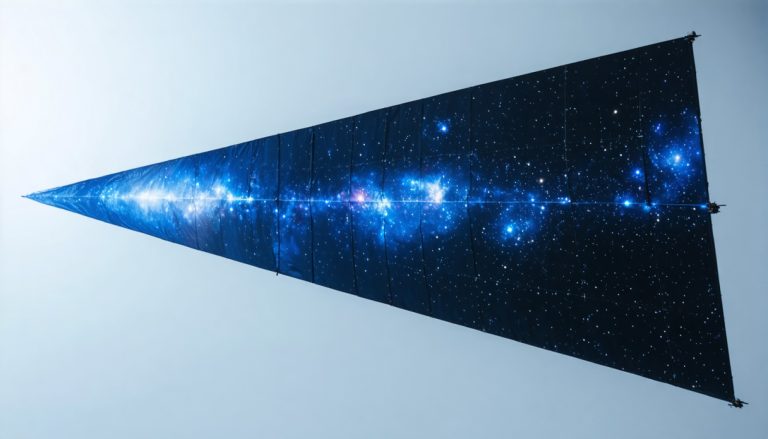
- Scientists have revived S. marinoi, a diatom from the Baltic Sea, dormant for up to 7,000 years, showcasing life’s resilience in harsh environments.
- Revived diatoms provide insights into Earth’s climatic shifts and ecological transformations.
- The James Webb Space Telescope (JWST) explores protoplanetary discs, revealing complex interactions between light and cosmic matter.
- Discoveries via JWST include unique ice absorption bands challenging current astrophysical models.
- Icy dust grains and polycyclic aromatic hydrocarbons (PAH) bands offer clues to planet and star formation in stellar nurseries.
- Interconnected studies of terrestrial and cosmic phenomena highlight resilience and innovative scientific exploration.
- These discoveries expand our understanding and appreciation of life’s persistence and the universe’s mysteries.
Deep beneath the waves of the Baltic Sea, a tale of extraordinary resilience and scientific wonder unfolds. This story centers on S. marinoi, a microscopic diatom that has lain dormant in anoxic sediment for up to 7,000 years, waiting for the right moment to spring back to life. Scientists have ventured into the eastern Gotland Basin, armed with cutting-edge techniques and an insatiable curiosity about life’s persistence in harsh environments. They have successfully revived various strains of these algae, painting a vivid picture of biological survival against the eons.
As researchers collect sediment cores from the shadowy depths of this storied sea, they unlock a narrative that stretches across time itself. These sedimentary layers are like pages in the book of Earth’s history, offering insights into climatic shifts and ecological transformations. The revival of these ancient diatoms is more than a biological curiosity—it is a testament to the potential of life to endure through epochs of change.
On a different plane, far from the terrestrial womb, another symphony of survival plays out amid the twinkling tapestry of space. The James Webb Space Telescope (JWST) peers deep into the cosmic darkness, revealing spectral notes of ice and dust on the protoplanetary disc surrounding Tau042021. Here, scientists grapple with the puzzling dialogue between light and matter—a complex dance choreographed by millennia of astrobiological evolution.
Utilizing JWST’s powerful gaze, researchers have detected unique ice absorption bands, stretching the boundaries of our understanding of these chilly cosmos ogres. Their presence challenges conventional radiative transfer models and compels astrophysicists to ponder the mysteries of dust grain size, shape, and chemical composition. Ingenious models attempt to replicate these celestial specters, employing mixtures that include silicates, amorphous carbon, and icy compounds like H2O, CO2, and CO.
In the heart of these windswept stellar nurseries, icy dust grains reveal themselves, rising from the disk into altitudes that defy isothermal hydrostatic expectations. Here, astronomical polycyclic aromatic hydrocarbons (PAH) bands etch an ethereal X-shaped light into the vastness, a cosmic graffiti of the invisible forces sculpting young planets and stars.
The stories of Earth and cosmos intertwine in this dance of resilience and discovery. The ancient diatoms whisper tales of a world long past, while the spectral songs from the edge of our galaxy hint at worlds yet to be born. These scientific endeavors, grounded in precision and curiosity, illuminate the enduring saga of life and the cosmos.
In both the depths of our oceans and the distant reaches of space, we see reflections of our past and glimpses of our potential future. The revival of the ancient diatoms and the insights from JWST remind us of life’s tenacity, pushing the boundaries of both knowledge and imagination. Our quest to understand these wonders enhances our reverence for the mysteries of deep time and the universe’s relentless creativity.
Unveiling Hidden Wonders: Unbelievable Discoveries from Ocean Depths and Deep Space
Resilience of Ancient Diatoms: A Testament to Life’s Persistence
The discovery of the diatom species S. marinoi in the Baltic Sea offers fascinating insights into Earth’s history and the tenacity of life. Here are some interesting facts and implications beyond the source material:
1. Understanding Dormancy and Revitalization: When these microscopic diatoms were revived after spending thousands of years in an anoxic environment, scientists gained new insights into dormancy mechanisms. These findings could have applications in biotechnology and agriculture, where resilience and longevity are crucial.
2. Climate Change Indicators: Sediment cores containing ancient diatoms serve as invaluable records of past climatic conditions. By studying these layers, researchers can reconstruct historical climate shifts, improving our understanding of Earth’s climate system and potentially aiding climate change mitigation efforts.
3. Potential Medical Applications: The unique properties of diatoms may have biomedical implications. Their silica-based cell walls could be used for drug delivery systems or in nanotechnology (Cited Source: ScienceDirect).
James Webb Space Telescope: Unraveling Cosmic Mysteries
The observations made by the JWST have revolutionized our perception of the universe. Here are additional facets to consider:
1. Astrobiology and the Search for Life: Detecting ice and molecular bands in protoplanetary discs can hint at the building blocks of life present in other star systems. This information is pertinent to the search for extraterrestrial life and understanding how planetary systems form.
2. Refinement of Radiative Models: The unique absorption bands observed challenge and refine our models of radiative transfer, prompting new theories in astrophysics regarding the interaction of light and matter in space environments.
3. Further Exploration of PAH: The presence of polycyclic aromatic hydrocarbons in space suggests possible chemical processes similar to those that might transport organic compounds around the universe, underpinning prebiotic chemistry.
How-To Steps & Life Hacks
– For Climate Researchers: Utilize sediment core analysis techniques to track historical climate patterns and apply these insights to predictive models.
– For Space Enthusiasts: Engage with open-source data from the JWST via NASA’s website to explore celestial phenomena and contribute to citizen science projects.
Real-World Use Cases & Predictions
– Carbon Sequestration: Leveraging diatom’s role in carbon capture could aid in reducing atmospheric CO2 levels, offering a natural solution to combat climate change (Cited Source: National Geographic).
– Future Space Missions: The insights gained from JWST will likely inform the design of future telescopes and space missions, focusing on detecting and analyzing distant exoplanets in habitable zones.
Conclusions and Actionable Recommendations
– Explore Interdisciplinary Research: Scientists and researchers should collaborate across disciplines to unlock the potential applications of these findings in climate science, astrobiology, and materials science.
– Engage with Public Science Initiatives: Individuals and educational institutions can enhance their scientific literacy and contribute to ongoing research efforts by participating in community science programs.
Explore more about astrobiology through NASA and investigate climate science innovations at Nature. These discoveries remind us of the interconnectedness of Earth’s history and cosmic evolution, inviting continued exploration and imagination.



